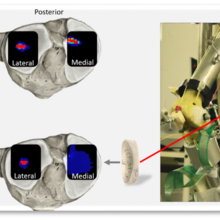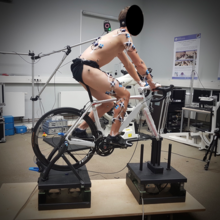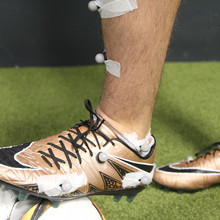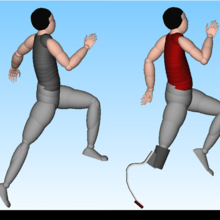Section Clinical and Technological Biomechanics
On-going Research Projects
Neuromuscular alterations in gonarthrosis
The research area includes the studies of neuromuscular changes in patients with gonarthrosis. The focus is on changes in the periarticular knee joint musculature, as well as the lower extremity, which are related to the development of the disease. In addition, the influence of orthotic devices , especially unicompartmental unloading gonarthrosis orthoses on neuromuscular structures will be investigated, with a focus on electromyographic examination.
Project lead:
Jana Rogoschin
Running, Sprinting und Jumping with a sport prosthesis
We investigate running, sprinting and jumping with a sports prosthesis. We consider and analyze the interaction between the prosthesis (technological component) and the musculoskeletal system (biological component) from a biomechanical perspective.
Project lead:
Univ. Prof. Dr. Wolfgang Potthast
Publications:
Funken et al., 2019, MSSE (Long Jump, kinetics)
Funken et al., 2019, RSOS (Long Jump, kinematics)
Funken et al., 2019, Sports Biomech (Curve Sprinting)
Willwacher et al., 2017, Scientific Reports (Long Jump)
Willwacher et al., 2016, PlosOne (Sprint start)
Brüggemann et al., 2008, Sports Tech (Running/Sprint)
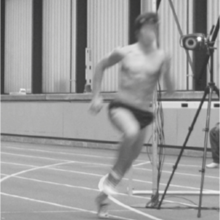
Curve Sprinting
We investigate athletic curve sprinting and aim for improved training methods, injury prevention and optimization of equipment.
Project lead:
Univ. Prof. Dr. Wolfgang Potthast
Publications:
Completed Research Projects
SensA-Chair
The aim of the project was to develop an intelligent office chair to reduce back pain in everyday life. By means of sensor technology in the backrest and seat, the intended design is to recognize the user's sitting posture and encourage him to change his posture by changing the shape of the two contact surfaces. The latter is to be achieved by shape memory wires. By frequently changing the sitting position, a long static load on the back muscles and passive back structures should be prevented and sitting comfort should be increased.
Outcome: In the course of the project, the IBO developed a stress model in which common sitting positions were evaluated with regard to their stress on passive and active back structures. This model was confirmed by tests with test persons and was subsequently incorporated into the development of the prototype. At the end of the project, a prototype was available that was able to identify six different posture categories and to encourage the user to change posture depending on the stress of the sitting position.
Further informationen:
Website project partner TH Köln
Project lead:
Univ. Prof. Dr. Wolfgang Potthast
Publications:
High tibial Osteotomy (HTO)
In this project, a model-based approach was developed to improve the surgical procedure of high tibial osteotomy. Based on pre-operative motion analysis, surgical planning will be individualized and more patient-specific.
Project lead:
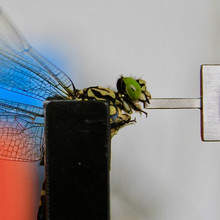
Biting forces of Dragonflies
In this project, the biting force of dragonflies was investigated and a contribution to questions of evolutionary biology was made with the help of detailed, self-developed muscle models. The transfer of the results to the development of high-tech, biologically inspired gripping tools is obvious.
Project lead:
Dr. Sina David
Univ. Prof. Dr. Wolfgang Potthast
Dr. Alexander Blanke
Publications:
Doctoral projects (completed)
Groin injuries in youth soccer
Groin injuries in junior soccer - how biomechanical risk factors and pubertal length growth are related [Translated]
2021
Abstract:
Groin injuries are a common problem in many sports and in soccer specifically. Nevert- heless, the underlying mechanisms are not well understood. The same is true for the increasing injury incidence, which occurs during the adolescent growth spurt. This work aimed to fill these two knowledge gaps. Therefore, four studies with a total of 105 par- ticipants were conducted. 3D motion analysis, combined with musculoskeletal modelling, was used as the main method. Depending on the study specific research questions, this main method was enhanced with other methods like EMG or dynamometry. The studies I and III were able to show that inside passing and changes of direction, both contribute to the risk of suffering a groin injury. Responsible for this are high amounts of eccentric contraction during both movements, sometimes combined with fast muscle lengthening. In the second and fourth study, it was shown that the growth during puberty increases the injury risk in general, but also specifically for the two previously investigated movements. Between the age groups of study II, the force needed to perform an inside pass, increased rapidly. This is triggered by a fast increase of the bodysegements’ inertial properties du- ring the adolescent growth spurt. The musculoskeletal system is not able to adapt to this increase appropriately and is therefore more susceptible to injuries during the adaptation process. However, it remains unclear if the phase of the fastest growth PHV additionally increases the injury risk due to changes in movement techniques. Although study IV found evidence towards this idea, the actual influence of PHV remains unanswered. Regarding the sport practice, the results indicate that injury prevention for adults in the form of specific strength of the adductor muscles is needed and should play a bigger part during training. In adolescent training this has to be treated with caution. Here, strength training should be used to prepare the athletes towards the increasing loads during the adolescent growth spurt. Increasing the training load during the growth spurt is discouraged to avoid an additional increase of the injury risk.
News:
Bericht in "Forschung Aktuell" (DSHS Mainpage)
Publications:
Intelligent wearables for the estimation of kinematics and kinetics
Development of intelligent wearables for the estimation of motion kinematics and kinetics
Marion Mundt
2020
Abstract:
Motion analysis gains more and more relevance because people are interested in gaining knowledge about their performance and it is possible to collect big data easily using wearable sensors. There are also more and more ways of collecting data in daily life. Nevertheless, motion analysis providing insight into joint kinematics and kinetics is still restricted to a laboratory set-up. To overcome this, the aim of this thesis was to take the first steps towards an easy-to-use and easy-to-interpret inertial-sensor-based motion analysis sys- tem. Due to the increasing amount of data available, the approach could be based on artificial intelligence models.
Artificial neural networks can be used to approximate the relationship between given inputs and outputs. During a training process, they learn to adapt their weights and biases to predict the output of unknown test samples. This thesis investigated if it is possible to predict the three dimensional angles and moments of the hip, knee and ankle joint and the ground reaction force using artificial neural networks based on inertial data only. For this purpose, a framework to simulate inertial sensors’ data based on marker trajectories collected by an optical system was developed and validated with a custom IMU system.
The results showed a good agreement of the predicted values and the ground truth data for gait and fast changes of direction. Employing data augmentation techniques to enlarge the dataset improved the results. The use of a fully-connected feedforward neural network resulted in a better pre- diction than the use of a recurrent LSTM neural network. Nevertheless, recurrent neural networks should still be considered for future work because they are able to make real-time predictions and do not need time normalised data like fully-connected feedforward networks. In a pilot investigation, the use of a convolutional neural network also seemed to be a promising approach. However, further steps are required to validate the methods developed in this thesis and bring an intelligent inertial-sensor-based motion analysis system towards application. The very promising results of this thesis prompt further research in this direction.
Long jump with lower leg prosthesis
Performance and loading characteristics in the athetic long jump with a transtibial prosthesis [Translated]
2019
Abstract:
Long jumpers with a below the knee amputation (BKA) who use their prosthesis for the take- off step are able to achieve remarkable performances. Yet, the underlying biomechanics are not comprehensively understood. However, knowledge of this is important for adapting training protocols, for distinguishing injury mechanisms, and for informing the devolvement of prosthetic design. Furthermore, the findings of this project might be a relevant source of information for future adaptation of olympic and paralympic regulations.
Within the framework of a multinational research project, from which the present dissertation results, motion analyses were conducted on three long jumpers with BKA and seven non- amputee athletes. Kinematics and kinetics during sprinting and the long jump take-off step together with athlete-specific anthropometrics served as input data for an inverse dynamic multi-segment model used for detailed three-dimensional analyses.
Athletes with BKA demonstrated different characteristics in terms of centre of mass (COM) and joint mechanics during sprinting and the long jump take-off compared to non-amputee athletes. Athletes with BKA had a slower run-up velocity but had a more efficient take-off step. During the take-off step, athletes with BKA positioned their prosthesis differently in relation to their COM compared to the foot positioning of the non-amputee athletes, and the COM motion characteristics were different between the two groups. In general, athletes with BKA had lower muscular-skeletal loading at the hip and knee joints during the take-off step, which results from shorter lever arms between the ground reaction force vector and the joint centres in athletes with BKA compared to the non-amputee athletes. The take-off characteristics of athletes with BKA were similar to the jump off a springboard, whereas the take-off step characteristics of non-amputee athletes resembled the known mechanism of “pivoting” to generate vertical take-off velocity.
As a result of mechanical constraints or limited muscular-skeletal capacities, long jumpers with or without BKA, respectively, illustrate motion characteristics, particularly during the take-off step of the long jump, which on the one hand are based on different locomotion mechanisms and on the other hand cannot be adopted by the other group.
Knee Joint Functionality in ACL Reconstructed Subjects
Comprehensive Assessment and Investigation of Knee Joint Functionality in ACL Reconstructed Subjects - Course of performance capacities from Pre- to Six Months Post-ACL Reconstruction
Frieder Cornelius Krafft
2019
Movement strategies for rapid changes of direction
Subject-specific movement strategies, musculoskeletal loading, and movement efficiency during rapid changes of direction [Translated]
2018
Abstract:
Fast cutting maneuvers are among the most frequent tasks during team sports games. Additionally, the ability to change direction in a short period of time is one of the most important parameters to identify talented athletes. Though numerous studies tried to identify performance limiting factors of this movement, it was not possible to generate scientific clarity as the results were controversy. Fast cutting maneuvers are also relevant in terms of injury risk as they are responsible for most of the non-contact anterior cruciate ligament injuries. The investigations regarding joint loading identified the segment orientation as relevant to reduce knee joint loading but were not able to draw conclusions on the movement mechanics of fast cutting maneuvers. Therefore, the underlying movement mechanics are insufficiently investigated and understood.
The aim of the present thesis was to gain a mechanical understanding of the cutting maneuver movement. Thus, the mechanical requirements and their realisation within different movement executions were investigated. As a result, the importance of preparatory strategies such as preorientation of the body and foot strike pattern was identified. These factors were than analysed regarding their relevance to load the knee stabilizing structures. Heel striking in combination with a low preorientation at initial touch down were identified to increase the load of the knee joint compared to fore foot striking combined with a pronounced preorientation. Furthermore, a range of habitual movement strategies were investigated regarding the efficiency of the movement. Therefore, the ground reaction force was transformed into the segments local coordinate systems which allows determining the direct influence of segment orientation on the ground reaction force vector. This approach supported the aforementioned results but additionally identified an optimum in movement execution regarding injury risk and the efficiency of the movement. A low preorientation and upright trunk position increased the knee joint load due to lateralisation of the ground reaction force vector. In contrast, a pronounced preorientation and tilt of the trunk decreased the capacity of the propulsive force. In order to prevent athletes from injury or to improve performance future studies should investigate the option to transfer the identified optimal strategy into the practical field. It will be of special interest to find out, why some subject execute the task with an inefficient or risky movement strategy.
Biomechanics of knee endoprostheses
Biomechanics of unicondylar and bicondylar knee arthroplasties in daily life activities [Translated]
2018
Abstract:
Knee arthroplasty is a successful and effective treatment for patients with degenerative end-stage knee osteoarthritis. The primarily aim of knee replacement is to relief pain and restore joint function. Generally, there is a distinction between unicondylar and bicondylar knee arthroplasty. In unicondylar knee arthroplasty only the joint compartment affected by osteoarthritis is replaced. Both cruciate and collateral ligaments are retained. Conversely, in bicondylar knee arthroplasty both the medial and lateral compartments of the tibia and femur are replaced. The anterior cruciate ligament is usually resected, whereas there are posterior cruciate ligament-retaining or substituting prosthetic designs. To date, unicondylar knee arthroplasty still represents a relatively small proportion of all knee arthroplasty surgeries. However, it is often hypothesised that unicondylar knee arthroplasty restores n o r m a l knee joint kinematics, in contrast to bicondylar or total knee arthroplasty respectively. This potential benefit of unicondylar knee arthroplasty has not been investigated under the consideration of activities of daily living. The aim of the current dissertation was a biomechanical examination of patients after a unilateral knee arthroplasty surgery compared to a healthy control group with regard to potential differences in terms of selected parameters during activities of daily living. There was a special focus on kinematics and kinetics in subjects with unicondylar knee arthroplasty compared to subjects with bicondylar knee arthroplasty.Gait analysis was performed by means of a 3D, 10-camera motion analysis system (VICON MX40, Vicon Motion Systems Ltd, Oxford, UK). Simultaneously, ground reaction forces were collected using force plates (Kistler Instrumente AG, Winterthur, CH). Electromyo-graphic raw signals were recorded at 1500 Hz from 8-channel telemetric electromyographic system (TeleMyo, Noraxon USA Inc., Scottdale, USA). The AnybodyTM Modeling System(AnyBody Technology, Aalborg, DK) was used to perform lower-limb inverse dynamics according to the anatomical landmark scaled model. The subjects performed level walking, stair climbing and negotiated a ramp.Patients with bicondylar arthroplasty exhibited considerable impaired knee internal rotation in their replaced knee joint particularly during decline walking and stair climbing compared to the control group. Patients with unicondylar knee arthroplasty revealed impaired knee internal rotation only in comparison to their non-affected knee. No difference was found between subjects with unicondylar and bicondylar knee arthroplasty, regardless of the locomotion task.In the first place, congruency between the femoral component and tibial inlay serves as an explanation for the restricted tibial rotation around the longitudinal axis of the knee joint in subjects after total knee arthroplasty. Due to the congruency, rotational resistance is induced between the two joint components that constraints tibial transverse plane motion. Additionally, high friction between the artificial joint components and simultaneously relatively low internal rotation moment magnitudes during stair climbing and decline walking may exert a mechanical resistance that reduces axial rotation in both knee arthroplasty designs. Apart from the implant shape, high friction enhances torsional shear, acting on the bone-implant interface. This mechanism may lead to migration around the longitudinal axis and potentially to loosening of the tibial component. Co-contraction between the medial and lateral hamstrings, as an explanatory approach, appears not to restrict knee internal rotation in patients after knee arthroplasty surgery. Based on the results of the current dissertation, clear advantages of unicondylar knee arthroplasty compared to bicondylar or total knee arthroplasty in terms of normal joint kinematics and kinetics can not be confirmed.
